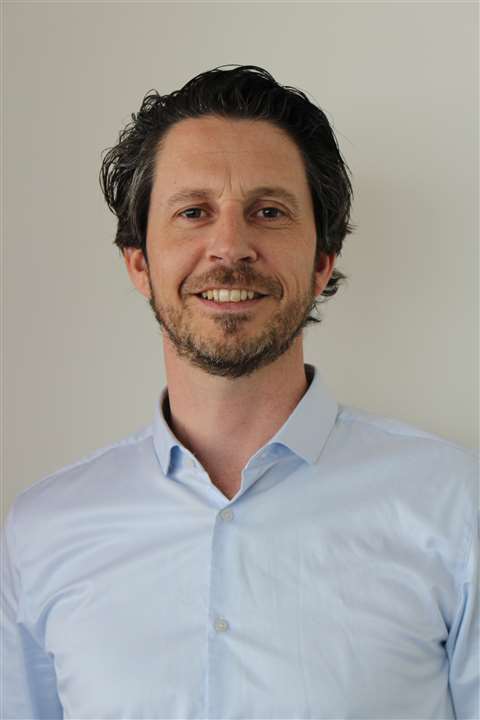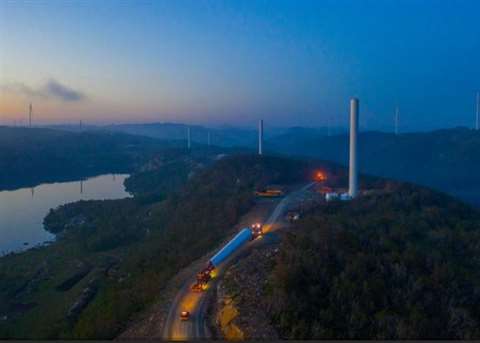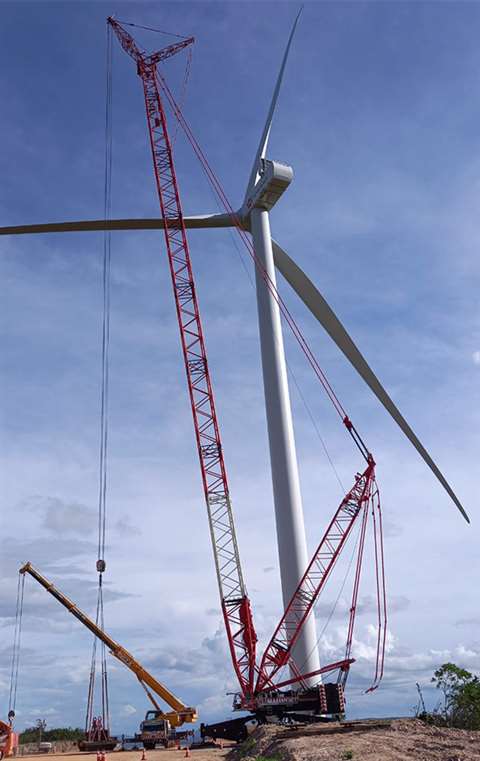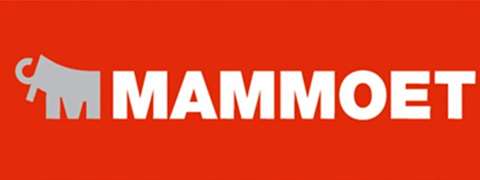Interview: Mammoet’s Pieter Jacobs on the quest for wind energy
12 August 2021
Alex Dahm quizzes Pieter Jacobs to learn about Mammoet’s plans for the future growth of onshore wind energy.
As consumers wish to pay as little as possible for electricity, then bringing down the cost of energy is a key requirement for any new installation of electrical generating capacity.
Renewable energy is making great strides in popularity over fossil fuel and other non-renewable ways of generating electricity. The International Energy Authority forecasts that electricity generating capacity from wind will increase by more than 60 GW a year until 2025, most of it onshore. Yet the world’s total generating capacity was less than that in 2005.
With so much work to do and new ground to be broken, has the time come to rethink how the supply chain operates? Could the sector be standardised globally to achieve greater levels of safety, operational performance and cost-effectiveness?
International heavy lift and transport specialist Mammoet is positioning itself at the forefront of renewable energy development, making extra investment to service the market.
Pieter Jacobs is not new to the company and finds himself in the new-fangled the role of global head of onshore wind.
He explained, “I am new in the job and it is also a new position. In the past we had a special business unit, Mammoet Wind in Denmark. We stopped it four or five years ago and integrated in the regions, but we see a growing market where there is a need to have global key account management.
“What we see is the onshore wind market still growing very rapidly, and there is only a certain number of cranes and erection companies in the world who can do it so there is pressure on capacity.”
Mammoet has been erecting turbines for the past 40 years and it is largely still the same thing – turbines are getting taller and heavier, but the lifting methods are more or less the same as 40 years ago.
How have the economics of the wind energy industry changed over the years?
There is still big pressure on bringing down the cost of energy. If you want to earn some money in this business you have to do it properly, lean and mean. Prices are only going down. But the costs we have – like labour, logistics and cranes – will not get cheaper.
The way to keep on bringing the cost down is to do it smarter. If you look into other methods of lifting, to be involved early on with clients, then you can look at the whole project cost, not only at the crane cost.
The civil element is a big thing. Reduction of the hardstand’s size, working with new methods or in a smarter ways, may result in direct project savings.
 Mammoet’s Pieter Jacobs explained “We have to change the whole way of erecting turbines”
Mammoet’s Pieter Jacobs explained “We have to change the whole way of erecting turbines”
Another very important aspect in the future will be the engine exhaust emissions, as there is great pressure for a project to be carbon neutral.
Some of our clients are already carbon neutral, so there will be pressure on the suppliers as well. We see that we are part of the solution, to cover that and to work on it and we have ideas.
It is quite a conservative market. If we are to push it to the next stage we really have to think creatively and we must do that with our clients.
It should be a common goal to do it smarter, with less harmful pollution. It is a big step as well we must take as a society.
Last year there was a big push, it is really changing and we will be part of it. We have to change the whole way of erecting turbines and we have ideas for that.
We have our WTA – the wind turbine assembly crane – which climbs with the tower. We need to partner with a turbine manufacturer because it has an impact on the tower. It is a very positive development.
With this development we will have smaller hardstands and roads onsite can be reduced. When we relocate, for example, a LG 1750, we must relocate maybe 700 or 800 tonnes every time from turbine to turbine.
With the WTA it is 100 or 150 tonnes. That is already a big difference just on logistics to the site and then onsite. It is much easier to work. I am sure in 10 years we will still erect with conventional cranes, but also with other methods.
Can the WTA erect the entire turbine, or do you still need a bigger crane for the larger components?
In principle the WTA can build the entire turbine. The original design, now two or three years old, is for turbine components with loads up to 150 tonnes.
Turbines are getting larger, so we may have to develop it for the next phase. We are discussing with OEMs to see how we can make it work, to see if it is financially feasible.
We also developed the WTA because we believe that hub heights will still further increase. In Europe we are now on 140m to 165m. Australia is going in the same direction. A common crane used by the wind farm developers over the past five to 10 years is the Liebherr LG 1750, with full SX3 boom, but there is a limit on that crane as well.
In the end you can put a bigger crane in there, like a CC 8800 or our LR 13000 but it will never be economically feasible to put a turbine in the air with these machines. If we want to go higher there is also a balance between more productivity for the turbine and the cost to erect it.
Does a 1,000 tonne capacity crawler crane not fit well in there?
Yes it fits, but if you go to hub heights of more than 200m that also has its limits.
We are not there yet but I would not be surprised if we will reach 200m hub heights within five years. The erection methods must be on the market and they must be financially viable.
How many units of the WTA crane would you imagine might join the fleet?
If it would be just one then we better build none because it would not be a success. It is going to be a success and it can easily be 10 or even more. I am a strong believer in it.
Mammoet’s approach is to get involved in projects at as early a stage as possible, to be able to give the best service. Is that working well in the wind industry and what are the benefits?
Yes, it is working but it is a mixed bag.
Sometimes it works well, on more remote and difficult sites where we are involved early and can look at different erection methods, for example, using tower cranes, looking to the hardstands and sitde roads in detail, looking into route surveys to the jobsite.
What about the contractual side?
We can take risks, but only risks that we can control.
Maybe in the past it was a little bit out of balance where we learned our lessons. We are really looking at it as well because contracting is key in this industry.
 Mammoet moves wind turbines in Norway
Mammoet moves wind turbines in Norway
With greater altitude comes stronger wind, does that mean you get winded off more often or for more of the time when you are putting up the taller turbines?
We will see in future that more time is required because of standby.
Some OEMs are putting day and night shifts in place on sites to maximise the time we can lift.
As locations for turbines become more remote, for example, in the middle of a forest, might tower cranes come into their own?
Yes, not everywhere and not on every project.
Yet on a lot of projects they are the best solution, from an operational perspective.
On the subject of subcontractors, to what extent do you use them, for the transport and erection-related work and is it increasing?
For transport we want to do it ourselves. We deliver the main crane and the crew and do the management. We do some subcontracting or leasing of the supporting cranes, which are very important because the relocation time will vary depending on the equipment you have to support your main crane.
If you do not have the right gear then it can easily take a few hours more. Then you are getting into contractual issues, because we committed to a certain relocation time.
What would you recommend for smaller local rental companies to do to get this subcontract work? What do they need in terms of equipment, people etc?
We would like to make sure they have the latest equipment available, giving us also service. We have a fixed fee for that relocation and then, when we start lifting, it is more on a time and material basis because we cannot control it.
We are trying to stick to the model that we are responsible for the risks we can control. We have a certain unit rate and lump sum for relocation. If we start renting subcontractors then they are more on a time and material basis.
It is perfect if we can have a flowdown of our own contract. It does not always work because if you just rent a crane it is on an hourly basis. They need to deliver on time with the right quality and safety.
Safety is a big aspect and there is a lot of improvement required on wind farms as there are quite a lot of incidents worldwide.
 Mammoet converts CC 2800-1 in Brazil
Mammoet converts CC 2800-1 in Brazil
What are the main problems you find are the causes of incidents?
What we most see in the industry see in the incident rate has to do with injuries to fingers, hands and feet.
There is always pressure on the schedule. I am not saying that is the cause, but it is not helping.
In the industry, we see that most incidents happen while erecting or dismantling a crane.
In a job for three months when you are standing in a refinery for example, you do that once. In the wind industry we do it weekly or even more.
In terms of the skills shortage, are you finding enough people or are you training your own?
We are doing both but there will be a big pressure on labour over the next few years, that is not only applies to us but the whole industry.
Finding and retaining skilled and experienced crane labour is a challenge. Not everybody wants to work on a wind farm. Many people just want to be at home at five or six o’clock. You are relocating a crane every week, so it is hard work.
Where are you working on projects, what is coming up, where is the next big wind market?
Scandinavia is very active and for the coming years. The United States is really getting hot, we are moving into a long contract there for a client at the end of the year with five main cranes.
Colombia is a market that is really developing and starting up, and Brazil keeps on pushing.
Australia has limited activity this year, but in 2022 that will also start over again with large projects of more than 200 turbines each.
STAY CONNECTED


Receive the information you need when you need it through our world-leading magazines, newsletters and daily briefings.





